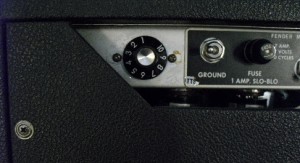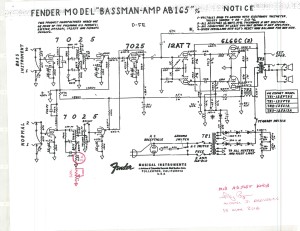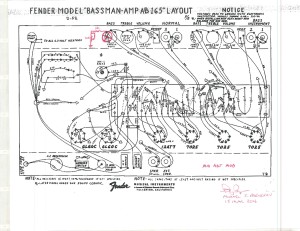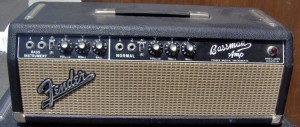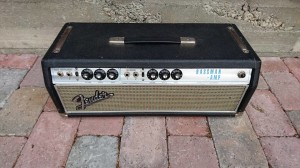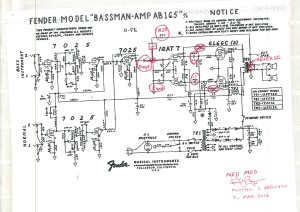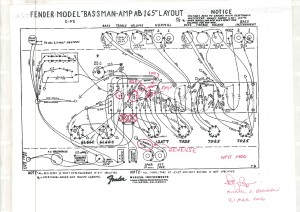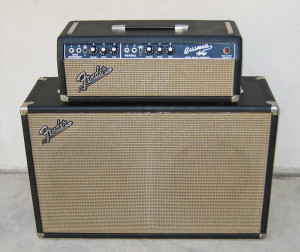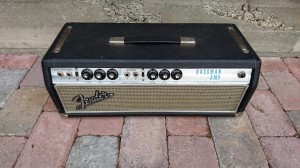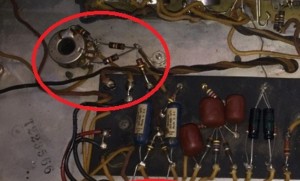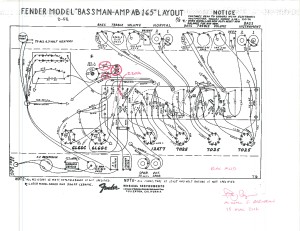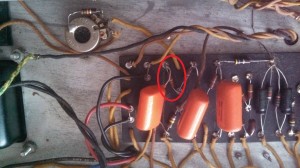This blog post will show you how EASY it is to end up with a Fender Bassman Bass Channel that is ‘guitar-usable’. This is done without even TOUCHING the tone stack. If you want an even MORE Marshall type tone, you can either make a few changes to the first gain stage’s cathode circuits and/or make some changes to the tone stack. (One such tone stack mod that I recommend might be to simply change the value of the slope resistor, so that the midrange isn’t so attenuated. I will go over this tone stack EASY mod at a later date.
DO NOT MODIFY A RARE LEO FENDER AA864 CIRCUIT!! ALSO, DO NOT ATTEMPT TO WORK ON THESE AMPS UNLESS YOU KNOW WHAT YOU ARE DOING, AS THEY CONTAIN VOLTAGES THAT ARE LETHAL AND WILL KILL YOU!!!
This is the fourth in a series going over exactly how easy it is to modify a Fender  Bassman. This EASY Bass channel mod is at the request of Jim G., my good friend. As always, you can click the schematics or pics in order to view them, or download them. If you need the hi-res schematics, simply ask and I shall email them. 😉 As you can see, I removed the .01 cap in parallel with the
Bassman. This EASY Bass channel mod is at the request of Jim G., my good friend. As always, you can click the schematics or pics in order to view them, or download them. If you need the hi-res schematics, simply ask and I shall email them. 😉 As you can see, I removed the .01 cap in parallel with the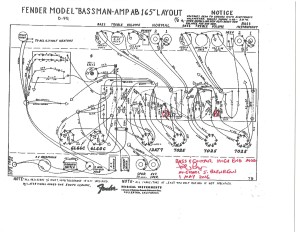 100K resistor. That cap basically gets rid of all the high frequencies, which you need if you plan to play guitar through the bass channel. (Remember to leave the deep switch OFF. If you want to use that channel for bass guitar again, simply turn the deep switch ON.)
100K resistor. That cap basically gets rid of all the high frequencies, which you need if you plan to play guitar through the bass channel. (Remember to leave the deep switch OFF. If you want to use that channel for bass guitar again, simply turn the deep switch ON.)  At the right, you see Jim’s amp that I have marked up to show the mod. (If you are paying attention, you may wonder what the cap that I have circled on the left does…. You can remove that 500pF cap in parallel with the 100K resistor in the guitar channel to ‘open up the high end’. You might just want to do that as well.
At the right, you see Jim’s amp that I have marked up to show the mod. (If you are paying attention, you may wonder what the cap that I have circled on the left does…. You can remove that 500pF cap in parallel with the 100K resistor in the guitar channel to ‘open up the high end’. You might just want to do that as well.
Below are two sound clips of before and after this bass channel mod. I was plugged into the 2 input on the bass channel, with the volume set to 3, and the treble and bass controls to 5. I was hooked into a 2X15 Sonic half stack using a 2005 Gibson SG with the selector set to rhythm, and the volume dialed way down to about 3 or 4. I recorded this using my cell phone, and set the app’s gain down about 16dB since this Bassman is extremely loud even with the volume set to 3. 😀
Bass Channel Unmodified
Bass Channel Modified

